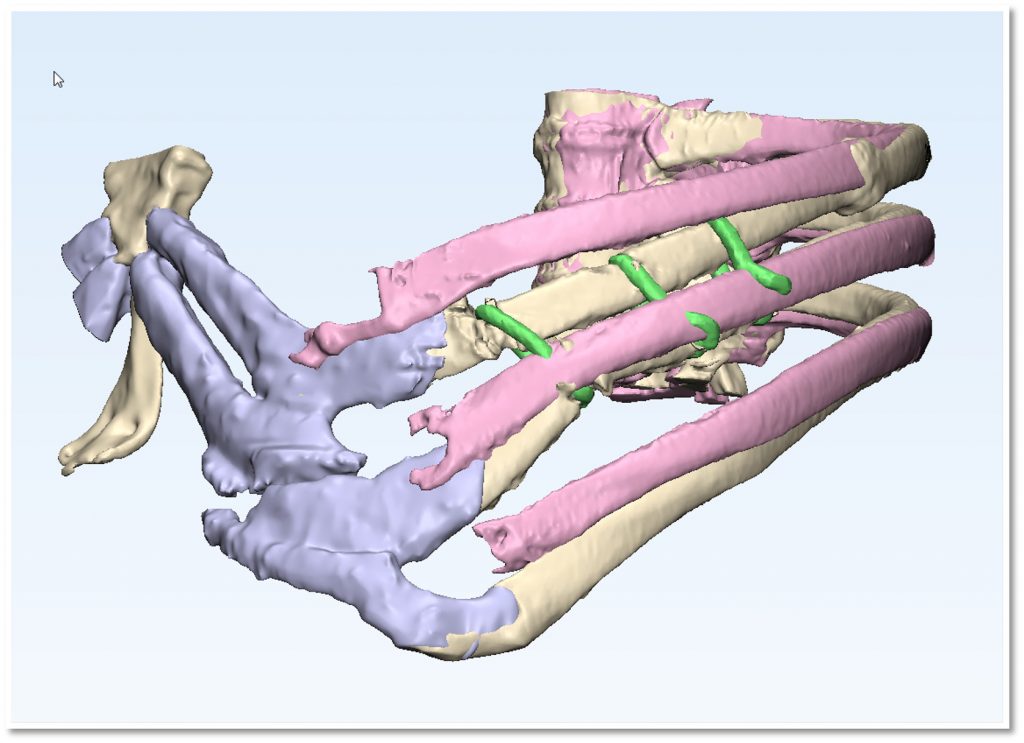 In the recently published ‘3D printed modeling contributes to reconstruction of complex chest wall instability,’ researchers from the Mayo Clinic Rochester look into new methods for creating 3D printed models and surgical planning devices for the treatment of complex conditions, pointing toward the example case of a 55-year-old male who underwent resuscitative thoracotomy after developing a pulmonary hernia—a condition usually caused by part of the lung bulging or tearing into the surrounding wall.
In the recently published ‘3D printed modeling contributes to reconstruction of complex chest wall instability,’ researchers from the Mayo Clinic Rochester look into new methods for creating 3D printed models and surgical planning devices for the treatment of complex conditions, pointing toward the example case of a 55-year-old male who underwent resuscitative thoracotomy after developing a pulmonary hernia—a condition usually caused by part of the lung bulging or tearing into the surrounding wall.
The researchers 3D printed two different models during the case study, with one demonstrating anterior fractured cartilage, and the right side acting as a mirror for the ‘normal ribs’ to demonstrate misalignment of the other side. The models were used to plan the surgery, involving a thoracotomy incision and more.
Chest trauma often requires surgical stabilization of rib fracture (SSRF). 3D printing has been reported as useful during intricate cases in the past for creating chest wall prostheses, but not with reconstruction using standard surgical tools.
“Given the compound curvature and dynamic anatomy of the chest wall, the utilization of patient specific 3D printed models to facilitate detailed operative planning prior to undertaking complex non-union or re-operative chest wall repair with SSRF presents a substantial opportunity,” stated the researchers.
The patient studied during this research had actually been stabbed, causing the trauma to his left chest area—also resulting in cardiac arrest. Surgery was performed, but the pulmonary hernia developed later and was repaired in a second procedure. He continued to be in pain, however, especially when laughing or coughing or stretching. As surgeons prepared to restore his chest wall with plates and bicortical screws, they used 3D printed models consisting of:
- Vertebral bodies
- Ribs
- Cerclage wires
- Cartilage
The models offered a clear perspective for the surgeons regarding areas like the disruption at the costosternal joint which was causing left chest distortion. As they continued to study the 3D printed models, the doctors were able to decide on their surgical approach. The authors point out, however, that reconstruction of the chest wall is a complicated procedure, ‘fraught with difficulties,’ to include:
- Malalignment
- Altered geometry
- Patient compensatory muscular hypertrophy
- Spinal changes
With 3D modeling, however, surgeons can optimize the entire surgical and possible implantation process too.
“Without 3D models, each individual case requires the surgeon, using two-dimensional non-life-size images, to create a 3D model mentally and then translate that to a life size plan. The patient-specific life size 3D printed model allows the surgeon to more easily comprehend and understand the anatomy without mental gymnastics,” state the authors. “These models offer a life size, multimaterial, tactile approach that was heretofore inaccessible. Secondarily, it allows the surgeon to pre-operatively bend plates to the patient’s specific anatomy, preprocedurally practice the osteotomies, and preoperatively have the plates sterilized, thus saving operative time.”

Overlaid model demonstrates the degree of mal-alignment based on mirror image data from the contra-lateral side.
As 3D printed models can be printed from the medical facility, all the benefits of 3D printing technology are recognized from affordability in production to speed to customization—and best of all, patient-specific treatment.
“At our institution, we have built an in-hospital centralized 3D printing facility to serve the surgical theater when complex cases arise. This allows point-of-care multidisciplinary collaboration and 3-D printing additive manufacturing expertise to the surgeons involved which accelerates innovative personalized care,” stated the researchers in their final discussion and conclusion.
“We believe that the early adoption of this technology by surgeons can help improve surgical quality and provide more individualized patient care. Centers should pursue the integration of 3D printed models into their practice and active collaborations between surgeons and modeling experts should be sought at every available opportunity.”
3D printing holds a special place in the world of medicine as the technology has made such sweeping changes in the way medical professionals are able to diagnose and treat other medical issues too like brain tumors, examine heart conditions with cardiac patches, and even create devices like 3D printed protheses for children with undeveloped eyes—and countless other issues making life much more tolerable for patients around the world. What do you think of this news? Let us know your thoughts! Join the discussion of this and other 3D printing topics at 3DPrintBoard.com.
[Source / Images: 3D printed modeling contributes to reconstruction of complex chest wall instability]Subscribe to Our Email Newsletter
Stay up-to-date on all the latest news from the 3D printing industry and receive information and offers from third party vendors.
You May Also Like
Profiling a Construction 3D Printing Pioneer: US Army Corps of Engineers’ Megan Kreiger
The world of construction 3D printing is still so new that the true experts can probably be counted on two hands. Among them is Megan Kreiger, Portfolio Manager of Additive...
US Army Corps of Engineers Taps Lincoln Electric & Eaton for Largest 3D Printed US Civil Works Part
The Soo Locks sit on the US-Canadian border, enabling maritime travel between Lake Superior and Lake Huron, from which ships can reach the rest of the Great Lakes. Crafts carrying...
Construction 3D Printing CEO Reflects on Being Female in Construction
Natalie Wadley, CEO of ChangeMaker3D, could hear the words of her daughter sitting next to her resounding in her head. “Mum, MUM, you’ve won!” Wadley had just won the prestigious...
1Print to Commercialize 3D Printed Coastal Resilience Solutions
1Print, a company that specializes in deploying additive construction (AC) for infrastructure projects, has entered an agreement with the University of Miami (UM) to accelerate commercialization of the SEAHIVE shoreline...































